Native
Acleris gloveranus (Walsingham) (Tortricidae: Tortricinae: Tortricini)
Common names: western blackheaded budworm
Synonyms: gloverana (Lophoderus)
FWLFWL:
forewing length; the distance from the base of the forewing to the apex, including fringe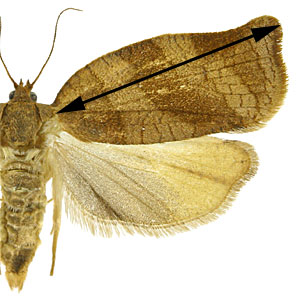 : 8.0-10.5 mm
: 8.0-10.5 mm
Forewing pattern is variable; Powell (1962) describes eight different forms. The most common forms are illustrated here. Most forms are similar to forms of A. variana (Fernald). Males lack a forewing costal foldforewing costal fold:
a flap or fold at the base of the forewing that contains specialized sex scales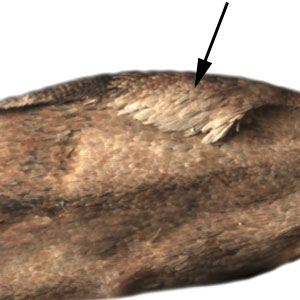 .
.
Male genitalia are characterized by a moderately developed uncusuncus:
a sclerotized process which is fused to the posterodorsal margin of tergum IX (often hidden behind tegumentegumen:
(often hidden behind tegumentegumen:
dorsal section of the transverse ring in male genitalia; often heavily sclerotized 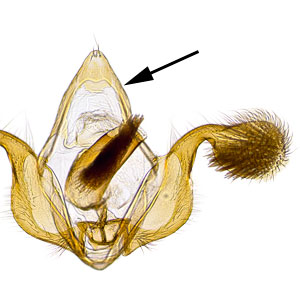 ); large, lobe-like sociisocii:
); large, lobe-like sociisocii:
a pair of lightly sclerotized setose lobes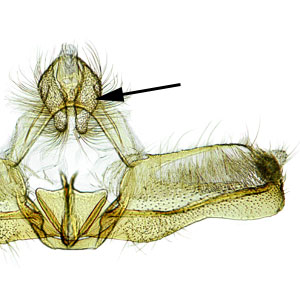 ; elongate, rectangular valvaevalva:
; elongate, rectangular valvaevalva:
an appendage flanking the intromittent organ that is used to clasp the female during copulation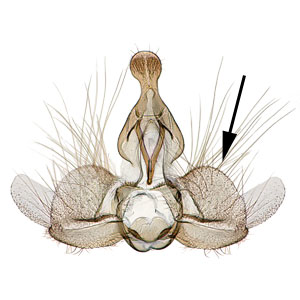 with well-developed sacculussacculus:
with well-developed sacculussacculus:
the ventral margin of the male valva  and ventrally pointed apical process. Female genitalia characterized by sterigmasterigma:
and ventrally pointed apical process. Female genitalia characterized by sterigmasterigma:
the sclerotized region surrounding the female ostium bursae  with large, triangular anterolateral lobes; cestumcestum:
with large, triangular anterolateral lobes; cestumcestum:
a long, bandlike sclerotization of the wall of the ductus bursae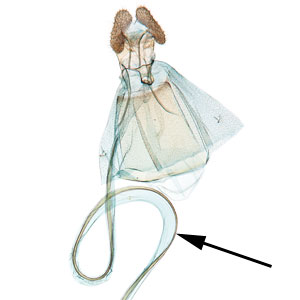 absent in ductus bursaeductus bursae:
absent in ductus bursaeductus bursae:
a membranous tube connecting the ostium bursae to the corpus bursae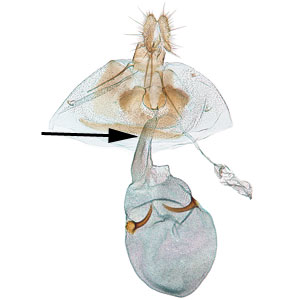 ; signumsignum:
; signumsignum:
a sclerotized projection or patch on the interior of the corpus bursae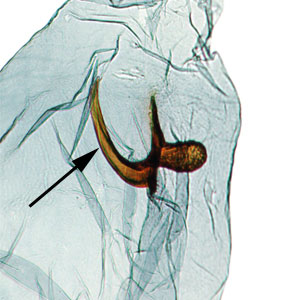 absent in corpus bursaecorpus bursae:
absent in corpus bursaecorpus bursae:
a dilated membranous sac at the anterior end of the bursa copulatrix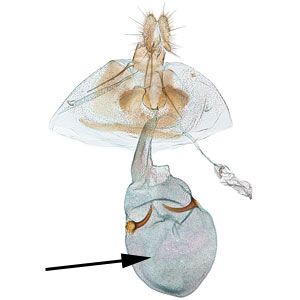
No detailed descriptions of larval chaetotaxychaetotaxy:
the arrangement of setae (in reference to Lepidoptera larvae), often depicted on a "setal map"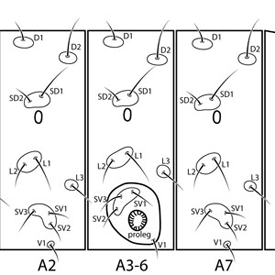 are available for Acleris gloveranus owing to its historic confusion with A. variana. The following account is based primarily on photos of larvae of A. gloveranus in western North America. Larval chaetotaxychaetotaxy:
are available for Acleris gloveranus owing to its historic confusion with A. variana. The following account is based primarily on photos of larvae of A. gloveranus in western North America. Larval chaetotaxychaetotaxy:
the arrangement of setae (in reference to Lepidoptera larvae), often depicted on a "setal map" probably closely mirrors that of A. variana.
probably closely mirrors that of A. variana.
Larvae are approximately 11-15 mm in length and are green with a black head that turns brown in the final instar. The prothoracic shieldprothoracic shield:
a sclerotized plate on the dorsal surface of the prothorax 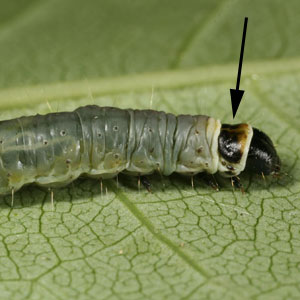 is green to brown and heavily shaded with black on the posterolateralposterolateral:
is green to brown and heavily shaded with black on the posterolateralposterolateral:
towards the rear and side; posterior and lateral 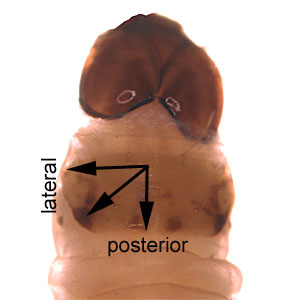 margins. If similar to A. variana, an anal combanal comb:
margins. If similar to A. variana, an anal combanal comb:
a toothed structure on the last abdominal segment used to eject frass away from the feeding larva; also termed "anal fork"  may be present with 6-10 teeth.
may be present with 6-10 teeth.
Acleris gloveranus is nearly identical to Acleris variana in both biology and morphology. The two species are geographically separated: A. gloveranus occurs in western North America and A. variana occurs in eastern North America. Powell (1962b) outlined minor genitalic differences that can be used to separate the two species. In males, the sacculussacculus:
the ventral margin of the male valva  is broader and less elongate in A. gloveranus, while it is narrower and more elongate in A. variana. In A. gloveranus females, the sterigmasterigma:
is broader and less elongate in A. gloveranus, while it is narrower and more elongate in A. variana. In A. gloveranus females, the sterigmasterigma:
the sclerotized region surrounding the female ostium bursae  is broad, with lobes connected, and a cestumcestum:
is broad, with lobes connected, and a cestumcestum:
a long, bandlike sclerotization of the wall of the ductus bursae is absent. In A. variana females, the sterigmasterigma:
is absent. In A. variana females, the sterigmasterigma:
the sclerotized region surrounding the female ostium bursae  is narrow with the lobes separate, and a weakly sclerotizedsclerotized:
is narrow with the lobes separate, and a weakly sclerotizedsclerotized:
hardened; usually in reference to larval structures or adult genitalia 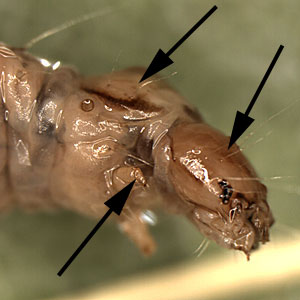 cestumcestum:
cestumcestum:
a long, bandlike sclerotization of the wall of the ductus bursae is present. In addition, females of A. variana have large abdominal scale tufts that are used to cover the eggs; these are lacking in A. gloveranus females.
is present. In addition, females of A. variana have large abdominal scale tufts that are used to cover the eggs; these are lacking in A. gloveranus females.
The following account is summarized from EPPO (1997)EPPO (1997):
EPPO (European and Mediterranean Plant Protection Organization). 1997. Data sheets on quarantine pests: Acleris variana and Acleris gloverana . https://gd.eppo.int/download/doc/797_ds_ACLRSP_en.pdf [accessed 15 October 2020] (.pdf). and Otvos et al. (2002).
Acleris gloveranus completes one generation per year. Adults are present in late July through September. Females lay single eggs on the underside of needles in the upper regions of host trees. Eggs overwinter until the following spring, and larvae hatch starting in mid-May. First instars feed inside opening buds, mid-instars web together needles to create a nest, and last instars are free-feeding. Males and 50% of females complete 4 larval instars while the remaining females complete 5 instars. Pupation occurs in webbed needles. Adults eclose in approximately two weeks.
This species can be a serious forest pest, and severe outbreaks can cover millions of acres. In coastal forests, extensive defoliation by A. gloveranus can result in up to 50% tree mortality. Outbreaks tend to occur after periods of low rainfall.
Acleris gloveranus feeds on a variety of fir, hemlock, larch, and spruce.
| Host plant | Host plant family | Reference(s) |
| Abies balsamea | Pinaceae | Powell 1964bPowell 1964b: Powell, J. A. 1964b. Biological and taxonomic studies on tortricine moths, with reference to the species in California. University of California Publications in Entomology. Vol. 32. 317 pp. |
| Abies concolor | Pinaceae | Powell 1964bPowell 1964b: Powell, J. A. 1964b. Biological and taxonomic studies on tortricine moths, with reference to the species in California. University of California Publications in Entomology. Vol. 32. 317 pp., 2006; Powell & De Benedictis 1996 |
| Abies magnifica (ID uncertain) | Pinaceae | Powell 2006Powell 2006: Powell, J. A. 2006. Database of Lepidoptera rearing lots, 1960-2005. University of California Berkeley, CA. |
| Abies sp. | Pinaceae | MacKay 1962aMacKay 1962a: MacKay, M. R. 1962a. Larvae of the North American Tortricinae (Lepidoptera: Tortricidae). Canadian Entomologist, Supplement 28: 1-182.; Powell 1964d; Powell & De Benedictis 1996 |
| Larix sp. | Pinaceae | Powell 1964bPowell 1964b: Powell, J. A. 1964b. Biological and taxonomic studies on tortricine moths, with reference to the species in California. University of California Publications in Entomology. Vol. 32. 317 pp. |
| Picea sitchensis | Pinaceae | Powell 1962dPowell 1962d: Powell, J. A. 1962d. Taxonomic studies on the Acleris gloverana-variana complex, the black-headed budworms (Lepidoptera: Tortricidae). Canadian Entomologist. 94: 833-840. |
| Picea sp. | Pinaceae | Powell 1964bPowell 1964b: Powell, J. A. 1964b. Biological and taxonomic studies on tortricine moths, with reference to the species in California. University of California Publications in Entomology. Vol. 32. 317 pp. |
| Pseudostuga sp. | Pinaceae | Powell 1964bPowell 1964b: Powell, J. A. 1964b. Biological and taxonomic studies on tortricine moths, with reference to the species in California. University of California Publications in Entomology. Vol. 32. 317 pp.; Powell & De Benedictis 1996 |
| Pseudotsuga menziesii | Pinaceae | Powell 1962dPowell 1962d: Powell, J. A. 1962d. Taxonomic studies on the Acleris gloverana-variana complex, the black-headed budworms (Lepidoptera: Tortricidae). Canadian Entomologist. 94: 833-840., 2006 |
| Tsuga heterophylla | Pinaceae | Powell 1964bPowell 1964b: Powell, J. A. 1964b. Biological and taxonomic studies on tortricine moths, with reference to the species in California. University of California Publications in Entomology. Vol. 32. 317 pp.; Shepherd & Gray 1990a, b; Powell & De Benedictis 1996 |
| Tsuga sp. | Pinaceae | Powell 1964bPowell 1964b: Powell, J. A. 1964b. Biological and taxonomic studies on tortricine moths, with reference to the species in California. University of California Publications in Entomology. Vol. 32. 317 pp. |
View full screen host table here
Acleris gloveranus occurs from Alaska and northwestern Canada south to northern California and western Montana.